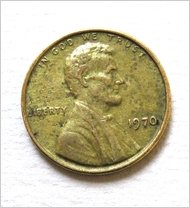When A Penny Saved is Ten-Thousand Pennies Earned

Pictured above is a penny. It’s an odd-looking penny, that’s for sure; it doesn’t have the reddish-brown hue that you’d expect, and it also doesn’t have the green tint that older pennies often develop. It’s more of a mustard yellow, which, if you think about it, suggests maybe there’s something amiss about this penny.
In fact, there is: it’s a counterfeit.
Why bother counterfeiting a penny? Well, this one isn’t worth a cent — it’s worth a lot more than that. A conservative estimate puts it at about $100 — and that’s before taking into consideration its artistic value.
In 2006, an artist named Jack Daws had an idea — a sculpture that no one would notice unless it was pointed out to them. He commissioned the creation of a mold which looked a lot like a penny, minus the mint mark. Then he invested in a bit of 14 karat gold, which he had melted down and poured into the mold. Finally, he took his gold pennies — he made a few of them — and had them copper-plated. He took one, carried it around in his pocket until it developed that easily-recognizable orange-ish coating called a patina, and then used it as if it were a real penny. And then, he waited for someone to notice.
Over time, as the counterfeit penny passed from one person to another, the patina began to rub away, revealing the much yellower metal behind it. Still, no one noticed that the penny in their possession was anything special — that is, until the summer of 2009. That’s when the penny came to a Brooklyn-based graphic designer named Jessica Reed — one who also happened to be, in the words of the New York Times, “a fan of unusual coins.” She had read something about a “golden penny” and, with the magic of Google, came across Daws’ website discussing his project. Reed then weighed her penny and found that it weighed a gram more than a penny minted in 1970 should. She contacted Daws who confirmed that Reed had won his Wonka-esque little contest.
Reed kept the coin, per the Times, and planned to hang it on her wall. That’s probably a smart move — the penny could be worth more than its weight in gold. It wasn’t the only golden penny Daws made; there are 10 others, and Daws sold one of them for $1,000 in 2008.
Bonus fact: If you need a penny and are in the Baltimore area, you can usually find one at Green Mount Cemetery. That’s the final resting place for John Wilkes Booth, the man who assassinated Abraham Lincoln — we think. The Booth family has a family plot there but there’s one headstone which is blank. That one is believed to be John Wilkes Booth’s, and rumor has it that his brother left unengraved to avoid vandalism. Today, though, visitors vandalize it regularly . . . kind of. Passersby regularly leave pennies on that grave — coins which depict Lincoln — as a way to send a symbolic message.
From the Archives: Pennies from Everywhere: How to pay for college, one cent at a time. (No gold pennies needed, either.)
